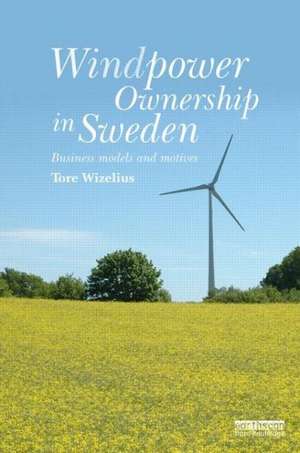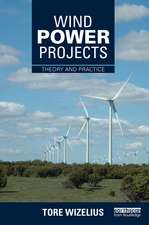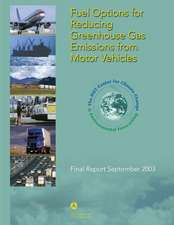Windpower Ownership in Sweden: Business models and motives
Autor Tore Wizeliusen Limba Engleză Hardback – 19 iun 2014
Several different ownership models, used in different countries, like windpower cooperatives, local limited companies, net-accounting models etc. are described. These models can be used to make windpower become community power, and/or consumer owned power, and produce power for these owners at cost price.
To wait for the international community to agree on international treaties to create a renewable energy system, takes too long. The climate disaster will inevitably happen. To speed up the transition to a renewable energy system, development has to come from below, from local communities, which can initiate and invest in windpower and other renewables. At the same time to get off from the oligopolistic electric power market and produce power at cost price is a good business.
Preț: 1167.71 lei
Preț vechi: 1424.03 lei
-18% Nou
Puncte Express: 1752
Preț estimativ în valută:
223.51€ • 242.87$ • 187.87£
223.51€ • 242.87$ • 187.87£
Carte tipărită la comandă
Livrare economică 21 aprilie-05 mai
Preluare comenzi: 021 569.72.76
Specificații
ISBN-13: 9781138021112
ISBN-10: 1138021113
Pagini: 224
Ilustrații: 53
Dimensiuni: 156 x 234 x 23 mm
Greutate: 0.57 kg
Ediția:1
Editura: Taylor & Francis
Colecția Routledge
Locul publicării:Oxford, United Kingdom
ISBN-10: 1138021113
Pagini: 224
Ilustrații: 53
Dimensiuni: 156 x 234 x 23 mm
Greutate: 0.57 kg
Ediția:1
Editura: Taylor & Francis
Colecția Routledge
Locul publicării:Oxford, United Kingdom
Cuprins
Acknowledgements Executive Summary 1. Introduction 1.1 Own Your Own Power Plant 1.2 Aim and Research Questions 1.3 Outline 1.4 Personal Background 2. Transition of Socio-technical Systems 2.1 Socio-technical Systems 2.2 Transition to Renewable Energy 3. Windpower in the Electric Power System 3.1 Properties of Windpower Plants 3.2 Integration of Windpower 3.3 Technical Acceptance 3.4 The Electric Power Market 4. Windpower Development and Ownership 4.1 Wind Turbines for Grid Connection 4.2 Ownership 5. Ownership Models in Sweden 5.1 Windpower Business Structure 5.2 Development of Ownership Models 5.3 Corporate Business Models 5.4 Cooperative Business Models 5.5 Real Estate Companies 5.6 Industrial Companies 5.7 Mixed Ownership 5.8 Umbrella Companies 5.9 Summary and Conclusion 6. Windpower Ownership in Sweden 6.1 Windpower development in Sweden 6.2 Ownership Categories 6.3 Other Ownership Categories 6.4 Community Power 6.5 Consumer Windpower 6.6 Summary 7. Windpower Owners’ Motives 7.1 Private Owners 7.2 Windpower Cooperatives 7.3 Windpower Limited Co 7.4 Other Companies 7.5 Power Companies 7.6 Municipalities & Municipal Utilities 7.7 Motives for Investments in Windpower 8. The Relevance of Windpower Ownership 8.1 Summary of Findings 8.2 Networks with Windpower 8.3 Advantages and Disadvantages 8.4 Adaption of Laws, Rules and Regulations 9. Future Outlook 9.1 Conclusions 9.2 Future Research References Appendix Appendix A. Interviews Appendix B. The Electric Power System Appendix C. The Nord Pool Market Appendix D. Windpower Owners in Sweden Appendix E. Abbreviations
Recenzii
'Anyone interested in a more democratic and sustainable energy future sooner or later looks to Scandinavia and the "community wind" models first developed there a quarter century ago. Though Denmark’s experience typically garners more attention, this book demonstrates that Sweden’s story is no less compelling: long before "crowdfunding" was all the rage, Swedes were experimenting with various windpower ownership models designed to facilitate investment in the fledgling wind industry. This book deftly describes how these models work, how they’ve evolved over time, and the challenges they face as the wind industry matures.' – Mark Bolinger, Lawrence Berkeley National Laboratory, USA
'Windpower Ownership in Sweden: Business Models and Motives, the new book by Tore Wizelius helps English-speakers understand how Swedes have taken a sizable ownership of wind energy in spite of their government. In this, his book can serve as an inspiration to community wind advocates worldwide who face many of the same challenges faced in Sweden.' - Paul Gipe, Renewable Energy Industry Analyst
'Windpower Ownership in Sweden: Business Models and Motives, the new book by Tore Wizelius helps English-speakers understand how Swedes have taken a sizable ownership of wind energy in spite of their government. In this, his book can serve as an inspiration to community wind advocates worldwide who face many of the same challenges faced in Sweden.' - Paul Gipe, Renewable Energy Industry Analyst
Descriere
This book discusses windpower ownership, with a focus on grid connected commercial wind turbines. It can be used as a manual for windpower project managers, for finding models to finance windpower projects.



























